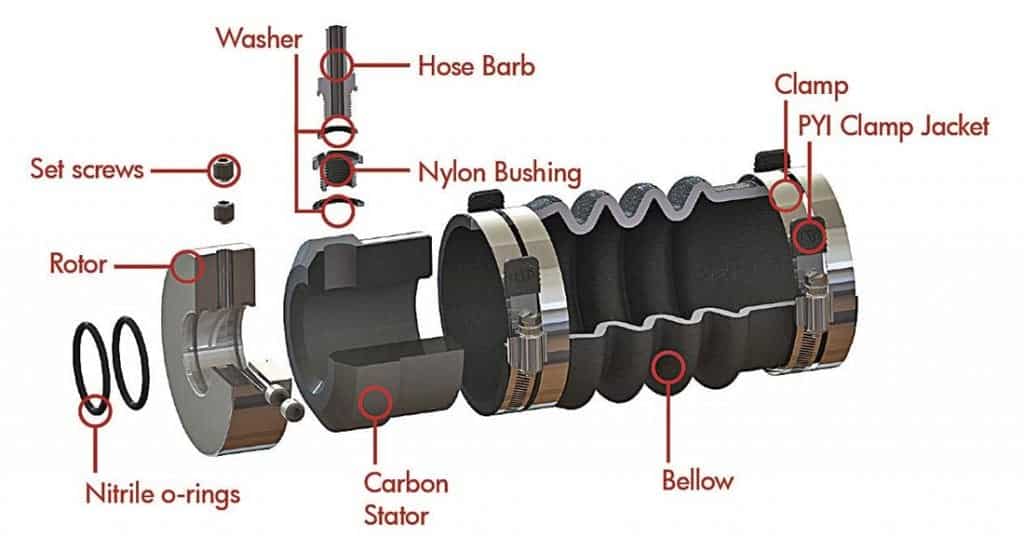Shaft seal maintenance should be part of your boat’s regular check-up.
Ever since the first prop was connected to the first shaft being turned by the first internal combustion engine, there has always been the dilemma of how to keep water from entering a boat through that all-important hole in the hull while also protecting the rapidly spinning shaft from the ravages of friction.
If your boating years go back as long as mine, you are familiar with the steady dripping of the practical, always carefully attended-to stuffing box. This most important piece of gear housed a series of packing rings—numbering three to five and often made of braided flax rope—coated with a waterproof material, and allowed the shaft to pass through the hull and keep turning while under power. It also prevented the water from getting in and flooding the bilges. Once properly tightened down by a collar, the rings were compressed enough to allow a few drops of water every minute or so to “leak” in, permitting the shaft and the packing to be cooled enough to prevent scoring the metal surface or “burning” the packing.
But as with all things in the marine industry, a change was due. Enter the dripless shaft system. Utilizing highly machine-polished, mechanical mating surfaces held together by pressurized tension on a rubber bellows surrounding them and a hose connection between the intake side of the engine’s raw water pump and the device, they have become the familiar norm in most applications.
One of the big downstream concerns associated with the old stuffing boxes was one created when there was a more than acceptable raw water flow. Sprayed outward by the spinning shaft, the ensuing salty mist would, of course, hasten corrosion to any metal it landed on. With a fully encased design, shaft seals alleviate this problem.
[photomosaic type=”rectangular” ids=”4969,4970″]
“We were most likely the first to use a rubber lip seal lubricated by raw water from the engine, replacing the traditional packing,” says Tides Marine engineering and quality control manager Skip Lookabaugh.
Overheating the housing can be trouble. In most cases, this is caused when air is allowed to accumulate inside due to most inboard engine drive shafts being installed on an angle, thus creating bubbles that can travel up the shaft. Dripless systems use the pressurized lubrication water to force any air out.
Dirt and grit can get sucked up if you run aground or operate in shallow, sandy bottom areas. And watch out for fishing line as well. “As with all devices with moving parts, if you notice a slight leak that steadily increases over time, you might want to check inside,” Lookabaugh adds. Prevention includes examining the lubrication system, hoses, clamps, and pump on a semiannual basis. Lookabaugh also recommends changing the lip seals on Tides’ equipment every five or six years.
Lou Foster, Duramax’s vice president of sales, also offers some maintenance insight and highly recommends regular visual inspections, especially if you have had any work done in the shaft area where someone could have stepped on the seal. With boats that have been sitting idle, there could be scale, sea growth or some other debris present. “Also, and while it should never happen, a noticeable bulge in the outer yellow bellows indicates something is causing the inner one to leak and should be taken care of,” Foster recommends.
“While we do have tolerances built in to allow for some misalignment and vibration, the main problem most boat owners would face occurs when something hits the running gear and really throws things out of whack,” explains Justin Romesburg, director of international sales for PSS. Therefore, should there be any alignment or vibration question, it is highly recommended that you have your shaft seal checked as well.
The shaft seal systems on the market today are rather robust and will have a fairly extended longevity with regular and diligent preventive maintenance. Should you have any questions about your particular dripless shaft seal, it’s best to get in touch with the manufacturer and have it serviced. Keeping your boat on top of the water depends on it.
By Ken Kreisler, Southern Boating March 2014













